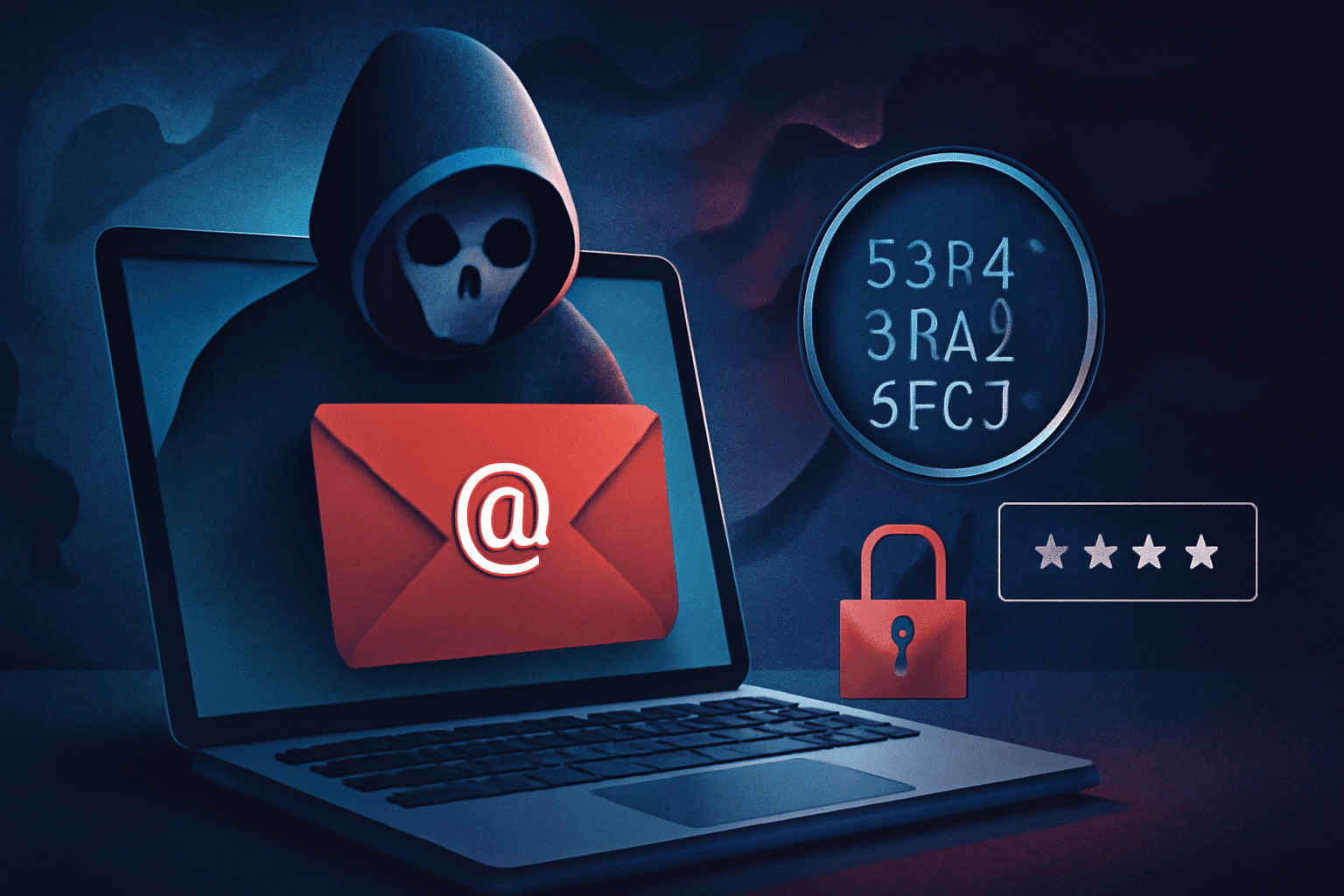Last Updated on May 15, 2025 by DarkNet
Discovering that your email address has surfaced on a dark‑web marketplace can feel like someone quietly copied the keys to your digital front door. It is a scenario millions confront every year, often after a routine data‑breach alert or a message from a monitoring service. While the phrase “dark web” may sound ominous, the real stakes are practical: stolen credentials give cybercriminals a head start on phishing, account takeovers, and identity fraud that can cost time, money, and peace of mind.
This article cuts through the jargon to explain exactly what it means when your email appears in underground forums, how criminals try to exploit it, and why the discovery doesn’t have to spell disaster. In the next sections you’ll find a concise action plan: immediate steps to secure your inbox and connected accounts, guidance on long‑term monitoring, and expert tips for reducing future exposure. By the end, you’ll know not only how to lock the door, but also how to install the alarm and keep watch on the neighborhood.
What It Means When Your Email Is Found on the Dark Web
The dark web is a collection of websites reachable only through anonymity networks such as Tor, where marketplaces operate beyond conventional search engines and law‑enforcement oversight. Among the most traded commodities are stolen email addresses paired with passwords, session cookies, or verification tokens.
Your address usually lands there after data brokers or criminals compile breach dumps, phishing harvests, or information leaked by a less‑secure business partner. Unlike public “paste” sites—temporary text bins that often remove illegal content—dark‑web forums keep archives behind paywalls or invitation codes, allowing buyers to cross‑reference multiple leaks, validate credentials in real time, and negotiate bulk discounts with little fear of takedown.
• In 2024, credentials from the MOVEit supply‑chain breach were auctioned in 2‑for‑1 bundles, letting attackers pivot into payroll portals within hours.
• A 2023 Telegram channel dumped 10,000 “.gov” emails harvested by a phishing kit masquerading as a Microsoft 365 login page.
• The 2021 LinkedIn data scrape, repackaged with password guesses, resurfaced on a dark‑web forum, enabling targeted spear‑phishing of recruiters.
• A small marketing vendor’s 2022 leak exposed customer‑service inboxes, later used for convincing business‑email‑compromise invoices.
How to Check Whether Your Email Really Leaked
The quickest way to confirm an exposure is to run your address through reputable breach‑notification services. Have I Been Pwned (HIBP) and Firefox Monitor (which taps the same database but adds friendly alerts) let you search for free; simply enter your email and they’ll list known breaches tied to it. Google One subscribers can also use the Dark Web Report in the Privacy & Security tab, which scans both public leaks and selected underground marketplaces. Each service compares your address against billions of stolen records, returning a summary in seconds without storing your query.
Reading the results takes a minute but matters. First, note the breach date—recent leaks may require faster action than a decade‑old incident. Next, look at the source: was it a social network, payroll vendor, or obscure third‑party app you forgot about? Finally, review the “compromised data” column; an exposed password or multifactor backup code is more urgent than a leaked birthday. Remember, free tiers cover only publicly shared dumps and verified breaches; they can’t guarantee visibility into every private forum or freshly stolen dataset, so consider premium monitoring if your risk profile is higher.
• Check the breach date and act immediately on anything from the past 12 months.
• Identify which service leaked your data so you know where to reset credentials.
• Review exactly what was exposed—passwords, phone numbers, security answers, tokens.
• If the listing is “unverified” or partial, treat it as a warning and enable deeper monitoring.
Risks and Real‑World Attack Scenarios
When criminals see your email circulating in underground forums, they treat it as an invitation. Phishing messages spoof banks or cloud apps, coaxing you to surrender passwords or 2FA codes. Meanwhile, credential‑stuffing bots test the address with billions of recycled passwords across retail, crypto, and payroll sites; even a single match can open the door to further fraud.
Attackers also weaponize breached inboxes for business‑email compromise (BEC), slipping fake invoices into real threads to divert payments. Beyond financial loss, doxing campaigns merge leak data with social profiles, exposing home addresses or private messages that damage careers and invite harassment. Once public, that information is nearly impossible to erase.
Key Threats
• Phishing & spoofing — deceptive emails harvest logins or payments.
• Credential stuffing — bots hijack accounts reused across sites.
• Social engineering (BEC) — forged corporate emails redirect funds.
• Doxing — personal details published for intimidation or blackmail.
Examples: In 2024 a charity lost $312 k after a spoofed CFO email changed wiring instructions. A 2023 Twitch streamer was swatted when doxers linked an old forum leak to public records. Holiday‑season bots in 2022 cracked 50 000 gift‑card logins within hours.
First‑Aid Checklist
-
Change passwords and enable 2FA. Reset the password for the breached service first, then any account that shares similar credentials. Store unique passphrases in a password manager and add app‑based or hardware two‑factor authentication to seal off quick re‑entry.
-
Revoke API tokens and app passwords. Hidden keys—such as OAuth tokens or “remember me” sessions—can survive a password reset and keep siphoning data. Remove every inactive or unfamiliar token, then generate fresh ones only for services you actively use.
-
Review forwarding, filter, and delegation rules. Attackers often create stealth rules that divert invoices or security alerts to an external inbox. Delete anything you didn’t set up yourself and lock down sharing permissions to trusted devices only.
-
Scan all devices for malware. Run a reputable antivirus or endpoint‑protection scan on every computer and phone that touches the account, and uninstall shady browser extensions. Clear cookies and reset saved logins to wipe hijacked sessions that might still be valid.
-
Notify banks or your employer if needed. If the compromised email is tied to payroll, vendor payments, or sensitive work projects, alert finance or IT teams immediately so they can flag suspicious activity and comply with any regulatory timelines.
Taking these steps within 24 hours transforms a scare into a solid upgrade of your digital defenses.
Removing Your Email from the Dark Web—Myth vs. Reality
Once your email address and any associated credentials are copied into a breach dump, they spread like digital spores. Files are mirrored across torrent archives, re‑uploaded to new dark‑web forums, and traded in private chat rooms. Even if one marketplace agrees to delete a listing, dozens of unchecked copies remain. Trying to erase every instance is like pulling a single thread from a sprawling, self‑replicating web.
Paid “scrubbing” or “removal” services promise to hunt those copies down. In practice, they scan public breach aggregators, issue automated takedown emails, and occasionally pay forum admins for deletion. The result is usually a partial purge—good for audit paperwork but ineffective against invitation‑only markets or fresh leaks that surface the next day.
The pragmatic approach is to devalue the stolen data: rotate passwords, enable two‑factor authentication, and watch for new exposures so you can react faster than attackers. Making the credentials worthless turns a permanent leak into a temporary annoyance.
|
Approach |
Pros |
Cons |
|---|---|---|
|
Paid removal / scrubbing service |
Quick, compliance‑friendly reports; can remove from some indexed leaks. |
Misses private forums; subscription costs; may request extra personal data. |
|
DIY monitoring & security hardening |
Cheap, puts you in control; strengthens accounts; real‑time alerts. |
Time‑consuming; reactive; no actual deletion. |
|
Ignore and hope for obscurity |
Zero effort or expense. |
Risk compounds; credentials remain weaponizable. |
Long‑Term Protection and Cyber Hygiene
Use a Password Manager and Unique Passwords
Store every login in an encrypted password manager that generates random, 20‑plus‑character passphrases you never have to memorize. Because each account now has its own key, a breach at one site can’t unlock another. Sync the vault across devices, back it up with a strong master passphrase, and review its health report monthly to replace any reused or weak entries.
Lock Accounts with Hardware 2FA Keys (FIDO2)
App‑based codes are good; physical security keys are better. FIDO2‑compatible devices such as YubiKey or Titan authenticate through a cryptographic handshake that resists phishing links, SIM swaps, and man‑in‑the‑middle attacks. Register two keys—one on your keyring, one in a safe place—and make them the default second factor for email, cloud storage, and password‑manager logins.
Deploy DMARC, SPF, and DKIM on Corporate Domains
If you manage a business or personal domain, publish Sender Policy Framework (SPF) and DomainKeys Identified Mail (DKIM) records, then enforce Domain‑based Message Authentication, Reporting, and Conformance (DMARC). These DNS controls tell receiving mail servers which hosts may send on your behalf and provide forensic reports on spoof attempts, dramatically cutting down on brand‑impersonation phishing.
Schedule Regular Breach Audits
Set quarterly reminders to run your primary and alias emails through services like Have I Been Pwned, Google Dark Web Report, or a commercial monitor. Log findings in a simple spreadsheet, note which credentials were rotated, and flag any patterns (e.g., recurring vendor leaks). Coupled with an incident‑response checklist, this routine turns surprise breaches into predictable maintenance tasks.
Comparative Review of Monitoring and Protection Services
|
Service |
Monthly Cost |
Accuracy |
Scan Depth |
Bonus Features |
|---|---|---|---|---|
|
Have I Been Pwned |
Free search / $3.95+ API |
High |
Public breach dumps |
Domain monitoring, API alerts |
|
Google Dark Web Report |
Free |
Moderate–High |
Public + selected dark‑web marketplaces |
Integrated Google Account alerts |
|
Aura Identity Theft Protection |
From $12 |
High |
Public + proprietary dark‑web crawls |
VPN, antivirus, $1 M insurance |
|
Bitdefender Digital Identity Protection |
≈ $6.67 (annual $79.99) |
Good |
Public + dark‑web + social footprint |
Impersonation alerts, breach guidance |
|
IdentityForce UltraSecure |
$19.90 |
High |
Public + dark web + credit bureaus |
Credit monitoring, $1 M insurance |
SWOT Summary: Free tools (Google, HIBP) excel in strength of zero cost and fast alerts, but their weakness is limited reach into invite‑only forums and no remediation help. Premium suites (Aura, IdentityForce) add depth, insurance, and bundled security—opportunities for users who want an all‑in‑one shield—yet higher prices may deter broad adoption. Mid‑priced Bitdefender sits between, offering social‑footprint scans but fewer financial safeguards. Across the board, the threat landscape keeps expanding as fresh breach sources and AI‑driven phishing reduce any single service’s coverage window, making layered defenses the most resilient strategy.
Legal Aspects and Corporate Responsibility
Under the EU GDPR, organizations must alert their supervisory authority within 72 hours of discovering a breach and then notify affected users “without undue delay.” Failure can lead to fines such as the €290 million penalty the Dutch regulator imposed on Uber in August 2024 for unlawful data transfers and delayed disclosure. In California, the CCPA obliges firms to implement “reasonable security” and to inform residents “in the most expedient time possible”; plaintiffs increasingly sue when companies fall short, alleging negligence rather than merely statutory violations. A fresh example is the class action filed on April 4 2025 against Capital One, accusing the bank of lax controls that exposed thousands of customers’ personal data.
Civil litigation is not the only pressure. After the 2023 MOVEit file‑transfer breach, five nationwide class actions were launched, and regulators referenced GDPR and state‑law duties in their investigations. National Computer Emergency Response Teams (CERTs) also play a pivotal role: US‑CERT publishes incident‑notification guidelines that federal contractors must follow, while India’s CERT‑In can order companies to report breaches within six hours and provide forensic logs.
Together, these frameworks create a three‑way accountability model: statutory notice, potential civil liability for poor safeguards, and technical oversight from CERTs. Companies that prepare breach‑response playbooks and maintain transparent channels with regulators are better positioned to avoid fines, lawsuits, and reputational fallout.
Comparisons and Analysis
|
Aspect |
Free Monitoring (HIBP, Google Report) |
Paid Monitoring (Aura, IdentityForce) |
|---|---|---|
|
Cost |
No fee; quick one‑off lookups |
$10–$25 per month, often bundled with extras |
|
Scan Depth |
Public breach dumps and select marketplaces |
Public dumps, proprietary dark‑web crawlers, credit bureaus |
|
Alert Speed |
Manual checks or periodic email notices |
Continuous scans with push, SMS, and phone alerts |
|
Remediation Support |
Self‑service guides and FAQs |
Live agents, insurance coverage, dispute handling |
SWOT Analysis – DIY Measures vs. Bundled Subscription
Strengths: DIY users keep costs near zero and learn first‑hand security skills; subscriptions deliver 24/7 monitoring, identity‑theft insurance, and concierge support.
Weaknesses: Free tools miss private leaks and place all incident response on the user; paid suites can lull customers into complacency and create subscription fatigue.
Opportunities: Combining a password manager, hardware 2FA, and periodic free scans narrows the gap without recurring fees; providers can add AI‑driven anomaly detection to justify premium tiers.
Threats: Ever‑growing breach volumes shorten the window between leak and exploitation, eroding both models’ coverage; regulators may cap data‑broker access, limiting scan depth for all services.
Case Studies
LinkedIn 2024: When a fresh 88‑million‑record scrape surfaced, users relying solely on free scans detected it within 24 hours, but paid subscribers received proactive phone alerts and pre‑filled dispute letters—highlighting the speed and support premium plans can add.
LastPass 2022: After the password‑manager’s vault backup was stolen, even top‑tier monitoring could not prevent brute‑force attempts on encrypted blobs; users who had implemented hardware 2FA and unique passwords weathered the incident with no account takeovers, proving that layered personal hygiene outperforms any single service.
Safety Tips and Recommendations
• Use a password manager to create and store unique 20‑character logins.
• Enable hardware or app‑based 2FA on every critical account—email, banking, cloud.
• Turn on automatic updates for all devices to patch vulnerabilities promptly.
• Set up account‑activity alerts and review them weekly for unfamiliar access.
• Delete dormant accounts and unsubscribe from unused services to shrink your attack surface.
• Back up key data offline or in an encrypted cloud vault to survive ransomware.
Small businesses hold payroll, invoices, and customer data prized by attackers yet rarely have dedicated security staff. Begin with an annual risk map that shows where data lives and who can touch it, then draft a one‑page incident‑response plan with clear contacts. Require hardware 2FA on finance tools, enforce strong‑password policies, run quarterly phishing drills, and carry cyber‑liability insurance that bundles breach‑response support.
-
Verify requests through a second channel. Call the sender or use in‑app chat before acting on urgent emails.
-
Slow down and inspect. Hover over links, check domain spelling, and watch for unusual tone or grammar that hints at impersonation.
-
Limit oversharing. Keep personal details scarce on social media; the less information attackers can mine, the harder it is to craft convincing lures.
Conclusion
Discovering your email on a dark‑web list is unsettling, but it’s not the end of your digital security story—only a signal to act. By changing affected passwords and enabling two‑factor authentication, revoking any lingering API tokens, and scanning your devices for hidden malware today, you immediately strip most of the value from the stolen data and shut down the easiest attack routes. Add regular breach checks and a password manager in the coming days, and what began as a scare becomes the catalyst for a stronger, more resilient online presence. Take those first three steps now, breathe easier knowing you’ve reclaimed control, and move forward confident that vigilance and good habits can outpace even the fastest‑moving cyber threats.













